| 18 November |
• yesterday • tomorrow |
| Optional Memorials of The Dedication of the Basilicas of Saints Peter and Paul, Apostles, and/or Saint Rose Philippine Duchesne, Virgin |

The Vatican church, dedicated in honour of Saint Peter, is the second patriarchal church at Rome, and in it reposes one half of the precious remains of the bodies of Saints Peter and Paul. The tombs of the great conquerors and lords of the world have been long since destroyed and forgotten; but those of the martyrs are glorious by the veneration which the faithful pay to their memory. Amongst all the places which the blood of martyrs has rendered illustrious, that part of the Vatican hill which was consecrated with the blood and enriched with the relics of the prince of the apostles, has always been most venerable. "The sepulchres of those who have served Christ crucified," says Saint Chrysostom, "surpass the palaces of kings, not so much in the greatness and beauty of the buildings (though in this also they go beyond them) as in another thing of more importance, namely, in the multitude of those who, with devotion and joy, repair to them. For the emperor himself, who is clothed in purple, goes to the sepulchres of the saints, and kisses them; and, humbly prostrate on the ground, beseeches the same saints to pray to God for him; and he who wears a royal crown upon his head, holds it for a great favour of God, that a tent-maker and a fisherman, and these dead, should be his protectors and defenders, and this he begs with great earnestness." And Saint Austin, or another ancient father. "Now at the memory of the fisherman the knees of the emperor are bowed, and the precious stones of the imperial crown shine most where the benefits of the fisherman are most felt."
The body of Saint Peter is said to have been buried immediately after his martyrdom, upon this spot, on the Vatican hill, which was then without the walls, and near the suburb inhabited by the Jews. The remains of this apostle were removed hence, into the cemetery of Calixtus, but brought back to the Vatican. Those of Saint Paul were deposited on the Ostian Way, where his church now stands. The tombs of the two princes of the apostles, from the beginning, were visited by Christians with extraordinary devotion above those of other martyrs. Caius the learned and eloquent priest of Rome, in 210, in his dialogue with Proclus, the Montanist, speaks thus of them: "I can show you the trophies of the apostles. For, whether you go to the Vatican hill, or to the Ostian road, you will meet with the monuments of them, who by their preaching and miracles founded this church." The Christians, even in the times of persecution, adorned the tombs of the martyrs, and the oratories which they erected over them, where they frequently prayed. Constantine the Great, after founding the Lateran church, built seven other churches at Rome, and many more in other parts of Italy. The first of these were, the churches of Saint Peter on the Vatican hill (where a temple of Apollo, and another of Idaea, mother of the gods, before stood) in honour of the place where the prince of the apostles had suffered martyrdom, and was buried: and that of Saint Paul, at his tomb on the Ostian road. The yearly revenues which Constantine granted to all these churches, amounted to seventeen thousand seven hundred and seventy golden pence, which is above thirteen thousand pounds sterling, counting the prices, gold for gold; but, as the value of gold and silver was then much higher than at present, the sum in our money at this day would be much greater. These churches had also a yearly income of above one thousand six hundred pounds upon the spices which Egypt and the East furnished. The churches of Saint Peter had houses at Antioch, and lands round about that city; at Tarsus, in Cilicia, and at Tyre: also in Egypt, near Alexandria, in the province of Euphrates, and elsewhere. A part of these lands was appointed every year to furnish a certain quantity of spikenard, frankincense, balm, storax, cinnamon, saffron, and other precious drugs for the censers and lamps. Anastasius gives a large account of the rich vessels of gold and silver which Constantine gave for the service of these churches; but, perhaps, confounded some later presents with those of this emperor. These churches were built by Constantine in so stately and magnificent a manner as to vie with the finest structures in the empire, as appears from the description which Eusebius gives us of the church of Tyre; for we find that the rest were erected upon the same model, which was consequently of great antiquity. Saint Peter's church on the Vatican, being fallen to decay, it was begun to be rebuilt under Julius II, in 1506, and was dedicated by Urban VIII, in 1626, on this day, the same on which the dedication of the old church was celebrated. The precious remains of many popes, martyrs, and other saints, are deposited partly under the altars of this vast and beautiful church, and partly in a spacious subterraneous church under the other. But the richest treasure of this venerable place consists in the relics of Saints Peter and Paul, which lie in a sumptuous vault beyond the middle of the church towards the upper end, under a magnificent altar, at which only the pope says mass, unless he commissions another to officiate there. This sacred vault is called, The confession of Saint Peter, or, The threshold of the Apostles, (Limina Apostolorum,) to which devout persons have flocked, in pilgrimages, from the primitive ages.
Churches are dedicated only to God, though often under the patronage of some saint; that the faithful may be excited to implore, with united suffrages, the intercession of such a saint, and that churches may be distinguished by bearing different titles. "Neither do we," says Saint Austin, "erect churches, or appoint priesthoods, sacred rites, and sacrifices to the martyrs; because, not the martyrs, but the God of the martyrs, is our God. Who, among the faithful, ever heard a priest, standing at the altar which is erected over the body of a martyr to the honour and worship of God, say, in praying: We offer up sacrifice to thee, O Peter, or Paul, or Cyprian; when at their memories (or titular altars) it is offered to God, who made them both men and martyrs, and has associated them to his angels in heavenly honour." And again: "We build not churches to martyrs as to gods, but memories as to men departed this life, whose souls live with God. Nor do we erect altars to sacrifice on them to the martyrs, but to the God of the martyrs, and our God." Constantine the Great gave proofs of his piety and religion by the foundation of so many magnificent churches, in which he desired that the name of God should be glorified on earth, to the end of time. Do we show ours by our awful deportment and devotion in holy places, and by our assiduity in frequenting them? God is everywhere present, and is to be honoured by the homages of our affections in all places. But in those which are sacred to him, in which our most holy mysteries are performed, and in which his faithful servants unite their suffrages, greater is the glory which redound to him from them, and he is usually more ready to receive our requests: the prayers of many assembled together being a holy violence to his mercy.
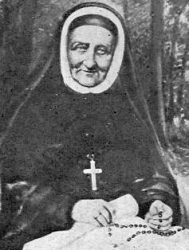
• The Lady of Mercy
• Woman Who Prays Always
Born to family with wealth and political connections; her father, Pierre Francois Duchesne, was a lawyer, businessman, and prominent civic leader in Grenoble, France, and her mother, Rose Perier, was a member of a leading family from the Dauphine region of France. From age eight Rose had a desire to evangelize in the Americas, sparked by hearing a Jesuit missionary speak of his work there. She received a basic education at home from tutors, and religious education from her mother. Educated from age 12 at the convent of the Visitation nuns in Grenoble, she joined them in 1788 at age 19 without the permission or knowledge of her family who were violently opposed to her choice, but finally gave in.
Religious communities were outlawed during the Reign of Terror of the French Revolution, and Rose's convent was closed in 1792. She spent the next ten years living as a lay woman again, but still managed to act like a good member of her Order. She established a school for poor children, provided care for the sick, and hid priests from Revolutionaries. When the Terror ended, she reclaimed her convent and tried to re-establish it with a group of sisters she had maintained in Grenoble. However, most of the sistes were long gone, and in 1804 the remainder was incorporated into the Society of the Sacred Heart under Saint Madeline Sophie Barat. They then re-opened the convent of Sainte-Marie-d'en-Haut as the second house of Sacred Heart nuns. Rose became a postulant in December 1804, and made her final vows in 1805.
In 1815 Mother Duschene was assigned to found a Sacred Heart convent in Paris, France. On 14 March 1818 at age 49 she and four sisters were sent as missionaries to the Louisiana Territory to establish the Society's presence in America. Diseases contracted during the trip to America nearly killed her, and after she recovered in New Orleans, the trip up the Mississippi nearly killed her again. She established her first mission at Saint Charles, Missouri, a log cabin that was the first free school west of the Mississippi River. She eventually six other houses in America which included schools and orphanages. She ran into some opposition as her teaching methods were based on French models, and her English was terrible; her students, however, received a good education, and her intentions were obviously for their best.
She was ever concerned about the plight of Native Americans, and much of her work was devoted to educating them, caring for their sick, and working against alcohol abuse. Finally able to retire from her administrative duties at age 71, Mother Duchesne evangelized the Pottowatomies, and taught young girls of the tribe. This work, however, lasted but a year as she was unable to master the Pottowatomi language. She was known to the tribe as "Woman-Who-Prays-Always".
She spent her last ten years in retirement in a tiny shack at the convent in Saint Charles where she lived austerely and in constant prayer.
29 August 1769 at Grenoble, France
18 November 1852 at Saint Charles, Missouri of natural causes
3 July 1988 by Pope John Paul II
• opposition of Church authorities - note that it was nothing to do with theology
• Springfield-Cape Girardeau, Missouri, diocese of
We cultivate a very small field for Christ, but we love it, knowing that God does not require great achievements but a heart that holds back nothing for self. - Saint Rose Philippine Duchesne
I live now in solitude and am able to use my time reflecting on the past and preparing for death. I cannot put away the thought of the Indians and in my ambition I fly to the Rockies. - Saint Rose Philippine Duchesne
https://catholicsaints.info/saint-rose-philippine-duchesne/
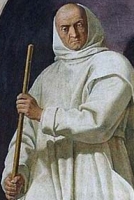
Born to the nobility, the son of Abbo. Raised in the courts of Count Fulk II of Anjou and Duke William of Aquitaine. Received the Order of Tonsure at age nineteen. Canon of the church of Saint Martin of Tours. Studied music and theology in Paris for four years, studying under Remigius of Auxerre. Returning home, he spent years as a near-hermit in a cell, studying and praying.
Benedictine monk at Baume, diocese of Besancon, France in 909, bringing all his worldly possessions - a library of about 100 books. Spiritual student of the abbot, Saint Berno of Cluny. Headmaster of the monastery school at Baume. Abbot of Baume in 924. Abbot of Cluny, Massey and Deols in 927.
In 931, Pope John XI asked Odo to reform all the monasteries in the Aquitaine, northern France and Italy. Negotiated a peace between Heberic of Rome and Hugh of Provence in 936; returned twice in six years to renegotiate the peace between them. Persuaded many secular leaders to give up control of monasteries so they could return to being spiritual centers, not sources of cash for the state. Founded the monastery of Our Lady on the Aventine in Rome. Wrote a biography of Saint Gerald of Aurillac, three books of essays on morality, some homilies, an epic poem on the Redemption, and twelve choral antiphons in honour of Saint Martin of Tours. Noted for his knowledge, his administrative abilities, his skills as a reformer, and as a writer; also known for his charity, he has been depicted giving the poor the clothes off his back.
c.879 at Le Mans, France
• 18 November 942 in Tours, France of natural causes while travelling to Rome, Italy
• buried in the church of Saint Julian
• most relics burned by Huguenots
for rain
https://catholicsaints.info/saint-odo-of-cluny/
Leonard Chimurra
His grandfather was the first Japanese person baptized by Saint Francis Xavier, and Leonard was raised Christian; he was related to Blessed Anthony Kimura. Attended the Jesuit school in Nagasaki, Japan. Served as lay catechist. Travelled with Jesuit priests on missionary trips. Jesuit Co-adjutor Brother, serving as cook and tailor. When the Jesuits were expelled from Japan in 1614, Leonard stayed behind and worked alone for years, living as a fugitive for his faith.
In 1619 he was captured with a small group of Christians. He was dressed as a Japanese gentleman, and the priest hunters had no idea they'd nabbed a Jesuit. At his trial the judge offered him the usual 200 pieces of silver if he would reveal the whereabouts of a Jesuit priest. Kimura said, "I know one Jesuit; he is a Co-adjutor Brother and not a priest, and I am that Brother." This admission sent him to prison. There he continued his mission as catechist, converted jailers and prisoners, and turned the prison into a Christian community with fixed times for prayer and meditation; this worked sent him to martyrdom.
c.1575 at Nagasaki, Japan
burned alive on 18 November 1619 before a crowd of 20,000 at Nishizaka, Nagaski, Japan
7 May 1867 by Pope Pius IX
https://catholicsaints.info/blessed-leonardus-kimura/
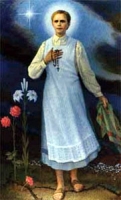
• Caroline Kózkówny
• Karolina Kózka
• Karolina Kozkowna
• Karolina Kózkówny
• the Maria Goretti of Poland
Fourth of eleven children born to the farm family of Jan and Maria Borzechka Kózka. Catechist. A teenaged virgin, she refused the advances of a Russian soldier. He kidnapped her, dragged her into the forest, and murdered her during an attempted rape. Martyr of purity.
2 August 1898 at Wal-Ruda, Poland
• murdered during a rape attempt by a Russian soldier on 18 November 1914 in the forests around Wal-Ruda, Poland
• her body was found on 4 December 1914
• buried at Zabawa, Poland
10 June 1987 at Tarnów, Poland by Pope John Paul II
https://catholicsaints.info/blessed-karoliny-kozkowny/
Mandé, Maodez, Maudet, Maudetus, Maudez, Maudé, Maw, Mawe, Modez
Hermit in an area of Cornwall, England; the area now has a village named Saint Mawes (Lannvowsedh in Cornish) in his honour. He emigrated to Brittany where he founded a monastery on an island now known as Maudez; he had to drive out the snakes and vermin in order to build. Worked with Saint Budoc of Brittany and Saint Tudwal to found the house. A nearby village is known as Lanmodez in his honour, and there are more than 60 churches in the region dedicated to him.
Wales
• 6th century of natural causes
• relics transferred to Bourges, France and Paris, France in the 9th century to escape invading Normans
• relics later returned to Brittany and spread around nine churches
• against insects
• against snakes
• against worms
• bishop
• schoolmaster
https://catholicsaints.info/saint-mawes/
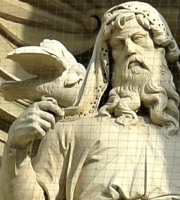
Noe, Nuh
Son of Lamech, and ninth patriarch of the Sethite line, who, with his family, was saved in the Ark from the Deluge, dying 350 years later at the age of 950. Father of Sem, Cham and Japhet. Many non-Catholics maintain that the Bible narrative is derived from a Babylonian epic, but numerous and important discrepancies render this untenable. The scriptural story is a parallel independent form of a common tradition.
rest - Hebrew
https://catholicsaints.info/noah-the-patriarch/
Andrew Toukan
Layman member of the Confraternity of the Holy Rosary in the archdiocese of Nagasaki, Japan. Arrested for sheltering missionaries. He was offered his freedom if he would deny Christianity; he declined. Martyr.
Nagasaki, Japan
burned alive on 18 November 1619 before a crowd of 20,000 at Nishizaka, Nagaski, Japan
7 May 1867 by Pope Pius IX
https://catholicsaints.info/blessed-andreas-murayama-tokuan/
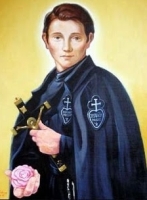
Grimoaldo of the Purification
Passionist cleric.
4 May 1883 at Pontecorvo, Frosinone, Italy as Ferdinando Santamaria
18 November 1902 at Ceccano, Italy of natural causes
29 January 1995 by Pope John Paul II
https://catholicsaints.info/blessed-ferdinando-santamaria/
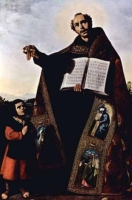
Romanus
Deacon in Caesarea. Preached publicly against Christians sacrificing to idols as a way to get along with pagan imperial authorities. For this he was imprisoned, tortured, his tongue cut and martyred in the persecutions of Diocletian.
strangled to death in prison in Antioch, Syria
https://catholicsaints.info/saint-romano-of-antioch/
Dominic Jorjes
Soldier. Immigrant to Japan. Layman. Member of the Confraternity of the Rosary. Arrested for hiding the Christian missionary Blessed John Spinola during a persecution of the faith. Martyr.
San Román, Aguiar de Sousa, Porto, Portugal
burned alive on 18 November 1619 in Nishizaka, Nagasaki, Japan
7 May 1867 by Pope Pius IX
https://catholicsaints.info/blessed-domingos-jorge/
• John Shoun
• John Xoun
Convert, baptized by Jesuits in the archdiocese of Nagasaki, Japan. Layman member of the Confraternity of the Holy Rosary. Martyr.
at Miyako, Japan
burned alive on 18 November 1619 at Nishizaka, Nagaski, Japan
7 May 1867 by Pope Pius IX
https://catholicsaints.info/blessed-ioannes-yoshida-shoun/
Layman member of the Confraternity of the Holy Rosary in the archdiocese of Nagasaki, Japan. Married to Blessed Agnes Takeya; father of Franciscus Takeya. Martyr.
in Korea
burned alive on 18 November 1619 before a crowd of 20,000 at Nishizaka, Nagaski, Japan
7 May 1867 by Pope Pius IX
https://catholicsaints.info/blessed-cosmas-takeya-sozaburo/

Barula
A boy of seven who learned Christianity from Saint Romanus the Abbot. When he publicly announced his Christianity, he was tortured and martyred in the persecutions of Diocletian.
beheaded in 303
https://catholicsaints.info/saint-barulas/
Momble, Momleolus, Mumbolus
Monk. Friend of Saint Fursey of Peronne. Abbot of Lagny in Meaux, France.
Ireland
c.690 of natural causes
https://catholicsaints.info/saint-mummolus-of-lagny/
• Amand, Amantius, Amatius
Abbot of Lérins Abbey in 676.
708 of natural causes
https://catholicsaints.info/saint-amandus-of-lerins/
One of a group of martyrs killed by Arian Vandals; the names of his fellow martyrs have not come down to us.
c.430 near Carthage, North Africa
https://catholicsaints.info/saint-oriculus/
Benedictine monk at Thouace in Anjou, France. Friend and co-worker with Saint Burginus.
c.1065 of natural causes
https://catholicsaints.info/blessed-guilminus/
Monk. Abbot. Martyr.
Vellaicum, Aquitaine (modern Velay, France)
https://catholicsaints.info/saint-teofredo-of-vellaicum/
Bishop of Mainz, Germany from 354 to 378. Greatly persecuted by Arian heretics.
378
https://catholicsaints.info/saint-maximus-of-mainz/
Sixth century bishop in Constance, Neustria (modern Konstanz, Germany).
https://catholicsaints.info/saint-romacario-of-constance/
Monk and later abbot of Lérins Abbey in France.
c.450
https://catholicsaints.info/saint-nazarius-of-lerins/
Eighth century abbot of Lérins Abbey in France.
c.750
https://catholicsaints.info/saint-anselm-of-lerins/
Hermit near Antioch, Syria.
782 of natural causes
https://catholicsaints.info/saint-thomas-of-antioch/
Friend of and co-worker with Saint Kieran.
6th century Cornwall, England
https://catholicsaints.info/saint-keverne/
Priest. Hermit at Lough Erne. Martyr.
Irish
777
https://catholicsaints.info/saint-constant/
Thousands of people were murdered in the anti-Catholic persecutions of the Spanish Civil War from 1934 to 1939. I have pages on each of them, but in most cases I have only found very minimal information. They are available on the CatholicSaints.Info site through these links:
• Blessed Amparo Hinojosa Naveros
• Blessed Augusto Cordero Fernández
• Blessed Carmen Barrera Izaguirre
• Blessed Emiliano Martínez de La Pera Alava
• Blessed Esteban Anuncibay Letona
• Blessed Francisco Marco Alemán
• Blessed Germán García y García
• Blessed Inés Zudaire Galdeano
• Blessed José María Cánovas Martínez
• Blessed Josefa Joaquina Lecuona Aramburu
• Blessed Laura Cavestany Anduaga
• Blessed Martina Olaizola Garagarza
• Blessed Modesto Sáez Manzanares
• Blessed Vidal Luis Gómara
CatholicSaints.Info Portable Edition